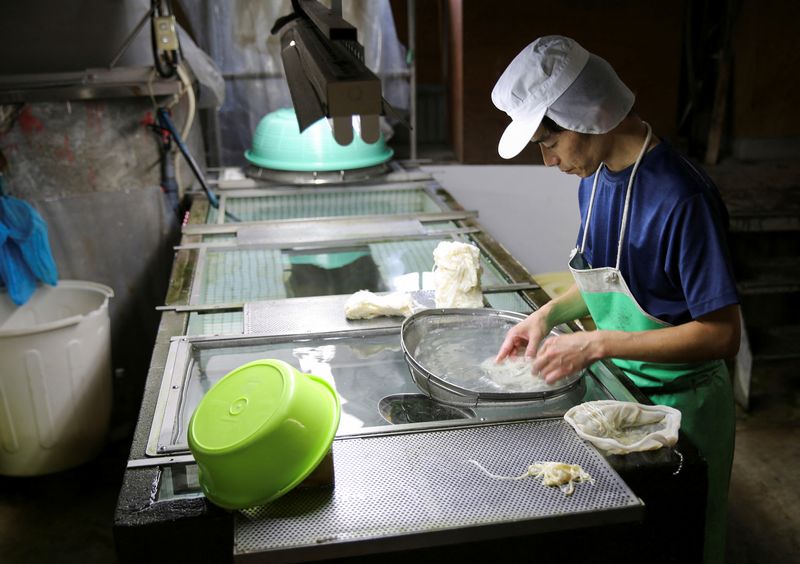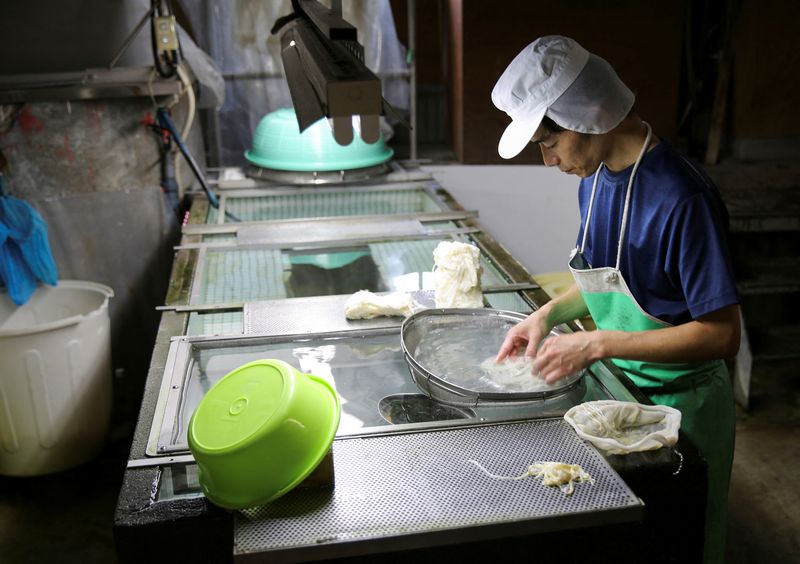
By Anton Bridge, Makiko Yamazaki
INO, Japan (Reuters) -Over the last decade, Masato Shiota brought his papermaking business back from the brink, paying down debt and buying machinery to automate some production. But he struggles to find workers to keep output at full capacity.
“We have three machines but only have two running on any day,” said Shiota, president of Wako Seishi, which produces tissues, disinfectant wipes and toilet paper in Ino, a town on the smallest of Japan’s four main islands known for its paper industry.
“If we don’t have the people we can’t make products and we can’t turn a profit. We’ll go under. This is the biggest problem for small and medium-sized companies.”
Shiota’s experiences and those of several other Ino business owners show how a labour shortage is a growing threat to smaller companies that provide seven out of every 10 jobs in Japan. The country faces a deficit of 3.4 million workers by the end of this decade and 11 million by 2040, according to a 2023 study by Recruit Works Institute.
In the first half of this year, a record 182 companies went under because of worker shortages, according to research firm Teikoku Databank, up 66% on a year earlier. Overall bankruptcies look set to surpass 10,000 this year, the highest since 2013, data from Tokyo Shoko Research showed this month.
While labour shortage-related bankruptcies are a small portion of the total, the surge will ripple through to these companies’ suppliers and customers, potentially causing a “chain of bankruptcies or mergers”, according to Takayasu Otomo, a researcher at Teikoku Databank.
Japan in March raised borrowing costs for the first time in 17 years, signalling the world’s fourth-largest economy had turned a corner after years of stagnation.
Yet Reuters interviews with 16 people, including business leaders in Ino, industry experts and officials, reveal challenges for Prime Minister Shigeru Ishiba’s efforts to revitalise rural economies facing ageing and shrinking populations.
While Japan is allowing more underperforming businesses to fail, the accounts suggest the worker shortage is threatening firms that are otherwise robust, including those that have invested in automation and creative hiring.
Japan’s Ministry of Economy, Trade and Industry did not respond to questions about the experiences of business owners in Ino.
‘ECONOMIC METABOLISM’
Shiota, who also heads the local papermaking association, has 42 employees and saw demand for disinfectant wipes surge during the pandemic.
He has cut out unprofitable products and, with government support, invested 80 million yen ($520,000) to automate his lines. But Shiota said he has little ability to pay workers more beyond a recent increase in the minimum wage, which will rise again next year.
Japan remains resistant to large-scale immigration, so some companies have plugged labour gaps by employing short-term workers from Vietnam and other Asian countries. But a weakening yen makes it harder to attract foreign workers.
Some Japanese officials see bankruptcies triggered by labour shortages as an inevitable effect of what they call “economic metabolism” – whereby less-dynamic companies are swept away, allowing workers and capital to migrate to more productive ones.
When asked about the rise in these bankruptcies, one senior official, granted anonymity to discuss a sensitive matter, said it was “natural” for such economic metabolism to take place.
The bankruptcy rate remains low compared with some countries, the official said, adding that if such bankruptcies did not occur, workers would be stuck at low-wage companies.
LEARNING TO ADAPT
Nestled alongside the Niyodo river, Ino is known for traditional products such as “Tosa washi” paper, made by hand for 1,000 years and used in calligraphy and on “shoji” sliding doors.
Given its population of 20,000 and location off the beaten track, Ino’s papermakers have carved out niches to survive. Toyo Tokushi, owned by the Moriki family, diversified into adult diapers in 1970, which now account for 70% of sales.
Faced with a staffing crunch, the company for the first time is considering hiring graduates straight out of high school, said Kei Moriki, the 32-year-old director.
Even so, he said he isn’t sure that the company can muster the resources to train employees with no work experience.
Old trophies from an annual softball tournament held by the local paper manufacturers association adorn the company headquarters. Toyo Tokushi hasn’t fielded a team in around 20 years, Moriki said, as his workforce has aged.
Elsewhere in Ino, there are few izakaya pubs left and only one fish shop, down from a dozen in 2007, according to locals.
Ishiba has given few details about how he plans to revitalise rural areas, but has promised to lay out a plan by early next year to raise the minimum wage by 42% by the end of the decade.
Meanwhile, the government is on a push to help small and medium-sized enterprises raise prices so they can hike wages that lag the OECD average. Higher wages would also help smaller companies attract workers.
But in Ino, business owners say it’s not straightforward.
Kashiki Seishi, a maker of washi paper, used to source everything from local farmers, according to chief executive Hiromasa Hamada. But since 2017 the six-person company has also depended on volunteers from a programme that allows people to work on farms in exchange for room and board.
“I don’t think it’s healthy for a business to rely on volunteers,” said the 44-year-old Hamada, a seventh-generation papermaker.
But he appears to have little choice, as there are fewer farmers in the nearby ranges to collect wood and other materials he needs.
In 10 years, he said, “there might be no one left in the mountains”.

